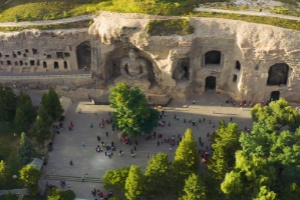 The Yungang Grottoes
The Yungang Grottoes
The Yungang Grottoes scenic area is located at the southern foot of Wuzhou Mountain, approximately 16 kilometers west of Datong City. It is an important site that integrates history, culture, and art. As one of the famous grotto groups in China, the Yungang Grottoes attract tourists with their grand scale and imposing presence. The excavation of the Yungang Grottoes began during the Northern Wei Dynasty and continued through multiple dynasties for approximately 150 years. This was a significant grotto and the construction of statues reflected the political, economic, and cultural conditions of the time. As the first grottoes authorized by the royal family in China, the Yungang Grottoes carry special political significance and represent the prosperity of Buddhist culture at that time.
In terms of artistic style, the Yungang Grottoes exhibit a blend of Chinese and Western cultures. They incorporate artistic elements from India and Central Asia, architectural forms, and decorative patterns from Greece and Rome. This diversity of artistic styles makes the Yungang Grottoes unique in Chinese grotto art and possesses high artistic value. Representative works such as the Open-air Buddha statue further enhance the charm of the scenic area. The Open-air Buddha, located in Cave 20 of the Yungang Grottoes, is a seated statue of Shakyamuni Buddha, standing 13.7 meters tall with sturdy stone material and well-preserved. With its solemn and dignified posture and exquisite carving techniques, this Buddha statue has become a landmark attraction of the Yungang Grottoes.
Must-see Attractions
The Buddha Statues
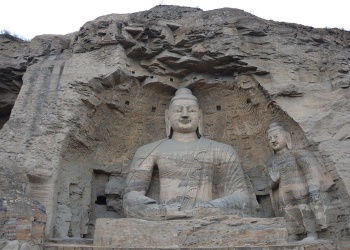 The Buddha Statues
The Buddha Statues
The Buddha statues of the Yungang Grottoes are located in prominent positions within the grottoes, with the most famous being the Yungang Buddha in Cave 5, affectionately known as the Yungang Buddha by the locals. This Buddha statue stands at a height of 17 meters, serving as one of the iconic attractions of the Yungang Grottoes. Its dignified form, with large ears reaching down to its shoulders, exudes a solemn and sacred aura.
In addition to the Yungang Buddha, there are numerous other Buddha statues in the Yungang Grottoes, either standing or seated, each with its unique form but all exuding a dignified and benevolent atmosphere. In terms of carving techniques, these Buddha statues also demonstrate the exquisite skills and remarkable talents of ancient craftsmen. The existence of these Buddha statues also reflects the religious beliefs and aesthetic concepts of the society at that time, providing valuable clues for us to understand ancient society.
The Yungang Grottoes Museum
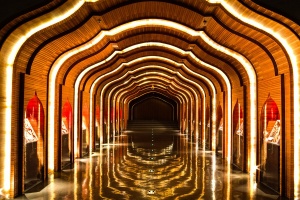 The Yungang Grottoes Museum
The Yungang Grottoes Museum
The Yungang Grottoes Museum is a modern museum specifically built to showcase and preserve the cultural heritage of the Yungang Grottoes. This museum is not only a platform for displaying the art of the Yungang Grottoes but also a bridge connecting history with modernity and tradition with innovation.
The museum has a reasonable internal layout and comprehensive functions. It consists of an exhibition hall and a multi-functional performing arts center. The exhibition hall is the core area of the museum, presenting the glorious history and unique charm of the Yungang Grottoes to visitors through a wealth of exhibits and multimedia display techniques. The exhibits include over 400 precious cultural relics, most of which are Buddhist statues, architectural components, and daily utensils unearthed in the Yungang Grottoes and surrounding areas from the Northern Wei Dynasty to the Ming and Qing Dynasties, presenting vivid historical scenes to the audience. The performing arts center is a venue that integrates performances, lectures, exchanges, and other functions, providing opportunities for visitors to gain a deeper understanding and experience of the culture of the Yungang Grottoes.
The Relief Wall Depicting the Ritual Worship
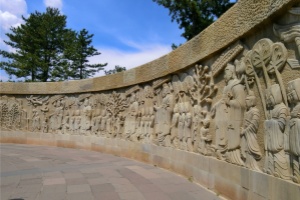 The Relief Wall Depicting the Ritual Worship
The Relief Wall Depicting the Ritual Worship
The relief wall depicting the ritual worship of Buddha in the Yungang Grottoes is a significant component of its ancient architecture and art, exhibiting the grand royal ritual worship scene of the Northern Wei Dynasty. This group of relief walls is located in a prominent position within the grotto complex, facing each other and forming an arc shape, with a length of approximately 20 meters and a height of about 4 meters. The composition of the picture is perfect, and the carving is meticulous, vividly reproducing the solemn and magnificent scene of the time in the form of high relief. The relief wall vividly depicts the ritual worship procession led by the emperor and queen, seemingly transporting people back to that remote era. This scene naturally conjures up the glory of the Yungang Grottoes as a royal temple more than 1,500 years ago, demonstrating the lofty status of Buddhism at that time.The relief wall fully embodies the artistic characteristics of the Yungang Grottoes. The use of high relief gives the picture a strong sense of three-dimensionality and vividness.
The Avenue of Worship
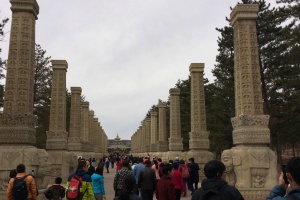 The Avenue of W orship
The Avenue of W orship
The Avenue of Worship is a must-visit path for tourists exploring the Yungang Grottoes. This avenue is renowned for its solemn and respectful atmosphere, and its exquisite stone carving art. On both sides of the avenue, thirteen pairs of Thousand-Buddha Columns are arranged in sequence, with each column towering at a height of 8.73 meters and carved from yellow sandstone. These columns are designed to be tall and elegant, with each segment - from the Sumeru pedestal, the Hercules-like figures, and the white elephants, to the column body itself - carved to life in intricate detail, exuding a profound sense of artistic beauty. Amidst the lush pine forests on both sides, these columns exude a majestic presence, seemingly connecting heaven and earth, creating a solemn and sacred religious atmosphere for the visitors.
Travel Informations
Opening hours
9:00-17:00(closed at 16:30)
Ticket price
Peak season April 1 - October 31
Adult full fare: 120 yuan/person
Student half fare: 60 yuan/person
Off-season November 1 - March 31
Adult full fare: 100 yuan/person
Student half fare: 50 yuan/person
Travel tips
1. Learn about the historical and cultural background: The Yungang Grottoes were built in the early fifth century and have developed over hundreds of years, with 53 niches and more than 51,000 Buddha statues. Understanding its historical and cultural background can better understand the importance and artistic value of the grottoes and increase the interest and significance of the tour.
2. Wear appropriate clothing and shoes: Since the interior of the grotto is mostly a narrow cave, different from the spacious and bright indoor scene, you need to pay attention to dress. It is best to choose shoes suitable for walking and crawling, and wear lightweight and comfortable clothing. In addition, due to the low temperature inside the grotto, it is recommended to carry a coat to prevent colds.
3. Respect and protect cultural relics: During the visit, please do not touch the murals and sculptures on the grottoes, so as not to cause damage to them. At the same time, do not litter or smoke in the grotto, keep the place clean and quiet.
4. Be safe: There are some steep steps and narrow passages inside the Yungang Grottoes, so be careful during walking and try to stay close to the side of the wall to prevent accidental collisions. Also, pay attention to the ground under your feet to avoid slipping or tripping.
5. Comply with the regulations of the scenic spot: Please visit according to the time and route specified by the scenic spot, and do not enter the non-sightseeing areas without permission.
6. Prepare the necessary items: you can bring some drinking water and simple food in case of emergency, but please be careful not to eat inside the grotto.




































